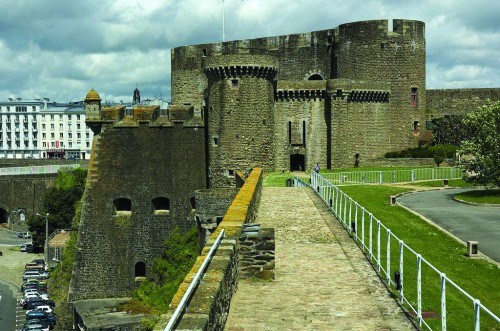A Day in Brest, France
Once one visits Paris, the power to appreciate the aesthetic aspects of other French cities is reduced. I experienced this disappointment the first time I took a day trip to Brest, in the region of Brittany, France. I knew the history, but for some reason I expected a little more grandeur, and more tourist-friendly transportation. […]
Once one visits Paris, the power to appreciate the aesthetic aspects of other French cities is reduced. I experienced this disappointment the first time I took a day trip to Brest, in the region of Brittany, France. I knew the history, but for some reason I expected a little more grandeur, and more tourist-friendly transportation. Instead, I found myself wandering the windy streets, with little to stop and see on the way. Historical monuments and buildings are hard to find throughout the city due to a massive reconstruction project after the city was razed at the end of World War II.
Finally I realized that I could not see much by walking, so we rented a car and set out to see the city. Sadly, even from the car there was nothing visible worth the stop. But, since Brest is a naval-based city, there are many spectacular views, ports, and seafood restaurants. During the summer, there are many more activities offered by local nautical clubs, such as surfing, jet skiing, wind surfing, and fishing. Unfortunately, I was there during late autumn, which left me searching for anything that could provide shelter.
The afternoon brought a satisfying lunch as well as the best historical sight a tourist can wish to find. Once I saw the ominous fortress off in the distance, I knew where to go. The Castle of Brest is a modern-day Maritime Academy, naval museum, and historical castle all wrapped in one. Due to the current use of the property, the castle is labeled the oldest functioning castle in the world, with over 1700 years of history. The museum briefly goes into the history behind the castle, and how that same history led to its current use. Paris may have a lot to offer, but nothing that is this old and that has faithfully maintained its original purpose into modern times.

The first impression I had once on the property was intimidation, which has historically been the goal. No need to worry, Kings, Dukes, Emperors, and Generals of the past, you made your point! In order to enter the museum, we had to first pass over a small bridge, (just a heads-up to those who suffer from vertigo, this may be a challenge). When over the bridge, there is a long outdoor passage to traverse before entering the museum; this is worth some extra time. The passage is actually made of remnants of Roman architecture and coinage, dating back to the rule of Emperor Septimus Severus (193-211). The history that this castle, and by association Brest, has endured over the years is at the very least inspiring; in the end, perseverance is a powerful tool.
Persevere they did: over the centuries, Brest has been conflicted with battles and wars, all with the purpose of obtaining the castle. The most well-known conflicts were those between the French, English, and Bretons. The Bretons were the inhabitants of the castle for centuries, as Brest did not unify with France until 1532. The power shifted often, but in every case the castle served the purpose of a stronghold to fend off enemies. Eventually, the power officially fell to the French, where it has comfortably stayed ever since. The most modern threat that came to the walls, which had everlasting effects on both the people and landscape of Brest, came during the Nazi invasion in 1940.
Nazi Germany became a penetrating threat to the castle on June 19, 1940 when Brest fell into the hands of enemy troops. Once more the castle’s prison was in use and its thick stone walls became more than a symbol of past battles. In August 1944, American and British allied troops began retaliation on the Germans. They knew that the Germans would have a devastating upper hand in the war if they could maintain power over the castle. A series of bombings lasted for forty-five days, culminating in the victory of Allied forces. However, the bombings destroyed most of Brest’s center, resulting in the plain streets and building that make up most of the city today. With millions left starved and homeless, the city was rapidly rebuilt from German reparation fees. This is why Brest lacks the historical architecture that Paris was allowed to maintain.
Today the castle serves as a museum of Brest’s naval history and is home to the Maritime Prefecture of France. The museum and Maritime Academy are the reasons that the Brest Castle is deemed the world’s oldest functioning castle. Tourists are not allowed to enter the Maritime Academy, but it is visible during the tour. The tour is self-guided and self-paced with an audio guide. Normally, during the earlier part of the day, the castle is empty apart from a few other tourists. This is a big difference from sightseeing in Paris, where every tourist attraction is beyond legal capacity any day of the week, at every hour. This gives each person the opportunity to appreciate every point of interest on the tour. The down side to the tour is that much of it is outside, on top of a very windy hill overlooking the ocean. This means being cold and uncomfortable, even during the summer.

Due to the popularity of Paris, many people miss out on Brest, which is too bad because the city has a lot to offer. In order to see the city, it is necessary to rent a car, or ask a local friend to show you around. The castle of Brest is the main attraction, well-presented, and easy to follow for any tourist. Anyone should take the opportunity to visit the Castle of Brest, because a 1700 year old functioning castle is a rarity these days.
Jacqueline Perrier-Gillette is currently a resident of Paris, France, where she lives with her husband. Together the two of them operate their small translation company, giving Jacqueline the opportunity to observe the French and their culture up close. She is an avid reader, writer, and student of foreign languages.
By Jacqueline Perrier Gillette





